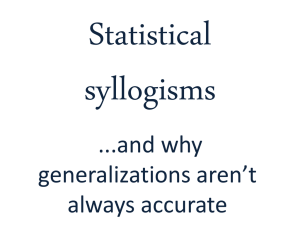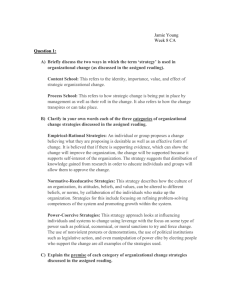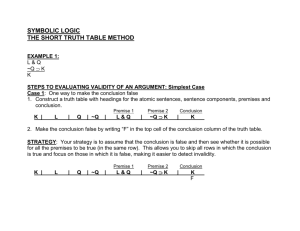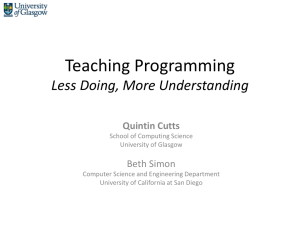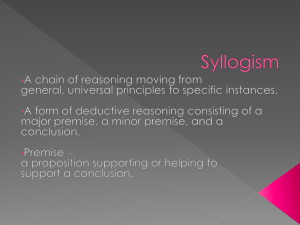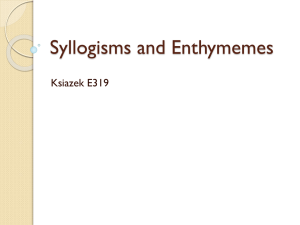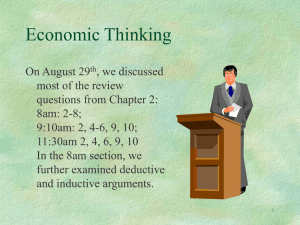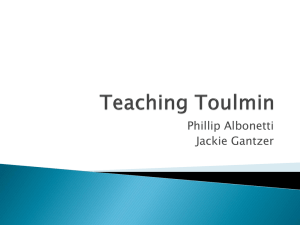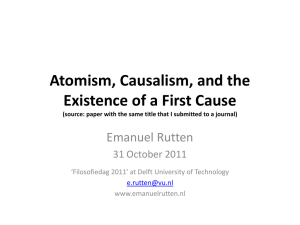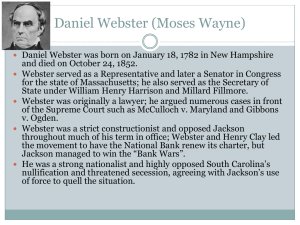Methods Presentation
advertisement
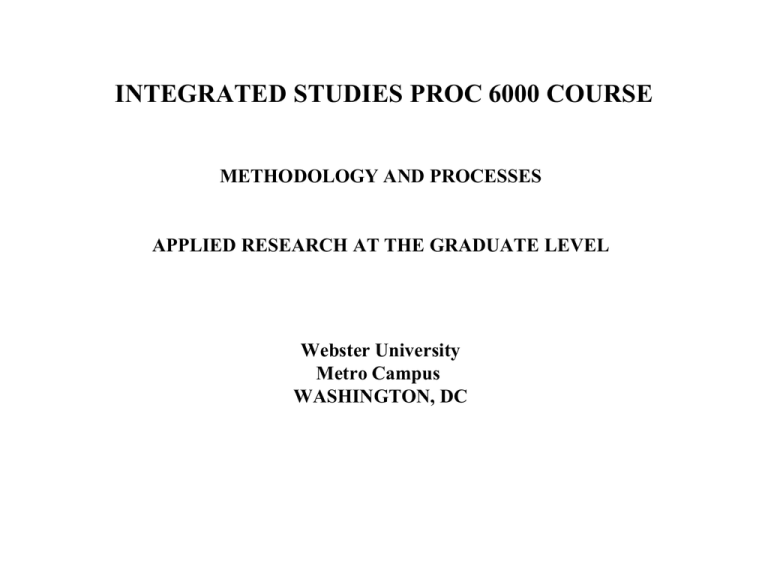
INTEGRATED STUDIES PROC 6000 COURSE METHODOLOGY AND PROCESSES APPLIED RESEARCH AT THE GRADUATE LEVEL Webster University Metro Campus WASHINGTON, DC Guidelines • Class attendance • Timely submission of assignments • Visit class website daily – – – – All emails through class website or webster.edu Assignments submitted within the website Discussion forums available More about class website on next page 2 Student Learning Assessment The PROC 6000 Course will be assessed using Webster's Assessment Tool. This must be completed by each student prior to the end of the term and consists of an ungraded assessment of all 6000 courses ongoing within Webster during this academic year. The results are non-attributable; however, the entire assessment must be completed and submitted at the same time you submit the final written project prior to completion of this course. The Assessment will be uploaded into the Assessment Assignment Area. We will discuss it further during our class sessions. 3 WEBSTER UNIVERSITY INTEGRATED STUDIES RESEARCH GOALS ARE: • STUDENTS SHOULD ACQUIRE AN APPRECIATION OF APPLIED RESEARCH AS A METHODOLOGY • STUDENTS SHOULD GAIN EXPERIENCE WITH APPLIED RESEARCH • STUDENTS SHOULD DEVELOP AN UNDERSTANDING OF APPLIED RESEARCH IN THEIR FIELD SO THEY CAN SOLVE MANAGEMENT PROBLEMS. 4 PROC 6000 Process Flow 5 APPLIED RESEARCH COMPONENTS 6 APPLIED RESEARCH • Aims to develop recommendations on management problems • Based upon an actual situation analysis • Develop a premise to focus research • Uses primary/secondary research to resolve business problems • Does not seek to discover new theory 7 SECONDARY RESEARCH (DEVELOP MODEL) • Libraries (http://libguides.webster.edu/Procurement) • Government • Trade Associations • Private Firms • Existing Case Studies • Historical Research • Case Studies • Internet 8 PRIMARY RESEARCH (VALIDATE MODEL) • • • • • Descriptive Survey Historical Survey Quantitative Study Experimental Study Empirical Analysis 9 DEVELOPING A SITUATION ANALYSIS AND PREMISE • Situation Analysis – analysis of a given situation is usually a situation that warrants a change. Use your own knowledge and experience plus secondary research to develop your analysis. • Premise – a statement used in applied research stating what is expected to be found in the research, or what will result after the prescribed action is taken. 10 More about the Premise A. Source of Premise – – – – – Lectures and reading in courses Exploratory reading on a particular topic Practical, on the job, problem awareness Reading specifics prior research Prior research experience B. Narrow the premise C. Clarify the premise D. State the premise precisely 11 PRIMARY RESEARCH METHODOLOGY • QUALITATIVE – SUBJECTIVE • HISTORICAL – SURVEY • QUANTITATIVE – STATISTICAL/EXPERIMENTAL • EMPIRICAL - OBSERVATION 12 Structure and Assignments Week Section Description 3 (Draft) 1 Situation Analysis: Describe the situation your project will explore. Note: Your completed situation analysis will include a description of the industry, the organization involved, its culture and the competitive environment together with the issue to be explored in your project. (Example: A description of a workplace with declining productivity.) Also, include those factors that caused you to select your particular subject. 3 (Draft) 2 Premise: Present a concise positive statement of what you propose to substantiate by the completion of the research project. Qualitative terms must be defined, and the premise should be measurable (Example: That productivity has been improved by Human Relations training.) In the example premise, the following terms would be defined in a presentation entitled "Definitions" immediately following the premise statements: a)Productivity, b) Improved, & c) Human Relations Training 3 (Draft) 3 Disclaimers or Study Limitations: Because the student realistically can deal only with limited variables, there should be statements of other variables not entertained in the study which could distort results or findings. (Example: The impact of unexpected massive layoffs.) 13 Structure and Assignments (cont.) Week Section Description 3 (Draft) 4 Work Plan I - Applied Research Methodology: This section tells what primary and secondary research methodology will be used in the paper. Blank survey instruments should be included. 3 (Draft) 5 Work Plan II - Core Course Content: This section should contain a discussion of which components from each core course were applicable and integrated into the project. It is expected that the student will use this section to be introspective about what he/she has learned in the program and carefully detail the subject matter which facilitated accomplishment of the project. It is recognized that the student may utilize only limited portions of content from various courses. If a particular course did not apply, state why. A significant focus of the student's evaluation will be the demonstrated ability to synthesize, apply and integrate the learning experienced in the core courses of the Webster program. 6 (Draft) 6 Project Development: The student will include a Project Plan consisting of a Gantt Chart depicting planned vs. actual progress for completion of this effort. 14 Structure and Assignments (cont.) Week Section Description 6 Draft) 7 Abstract of 3 to 5 pages: The abstract to be presented will be a brief synopsis and will include a summary of the project, the situation analysis, premise, study limitations, work plan, key findings, conclusions, acceptance, rejection or modification of the premise, and recommendations. (Two copies to be given to instructor at time student presents oral report.) 9 8 Actual Paper: The body of the paper will be 20-30 pages of original work. Use appropriate academic or business style. 9 9 Bibliography/Footn0te5 or Endnotes: Any presentation style is acceptable as long as it is consistently applied 9 10 Research Documentation: Questionnaires, tables, exhibits, charts and other inclusions must be provided as part of the project paper and may be placed in an appendix to your paper. 9 1-10 Finalize all previously submitted drafts (Sections 1-7) and submit Final Paper in one complete Microsoft Word format. 15 Protocols While any appropriate academic writing style and format may be proposed by the student, the Webster University - Bolling AFB Campus recommends that "A Manual for Writers", by Kate L. Turabian, APA, or another guide acceptable to the instructor. 16 Protocols (cont.) • Include a Table of Contents. • Clearly label each section and topic. • Start each new topic on a separate sheet. • Number the pages. • Provide the footnotes and bibliography in a consistent fashion. • Pay particular attention to spelling, grammar and punctuation. 17 Protocols (cont.) • Give appropriate recognition to any quotations or content presented which may not be the student's own original work product. • Make all submissions in typewritten format, double spaced on 8.5" x 11" paper in a suitable binder. • Understand that the original work and abstracts will remain in the possession of Webster University. 18 Protocols (cont.) • Demonstrate understanding of the findings as evidenced by your conclusions, reassessment of the premise, and recommendations. • Assess your findings in relationship to the literature, but more importantly, to your own original premise. • Recommend follow up actions or further study based on your findings • Offer a copy of your work to any company which offers their resources to you in doing your research. • Honor requests for anonymity 19 Questions? 20

